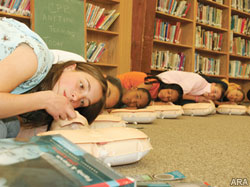(ARA) – When she spotted the dying man, Desiree Rossi took action when no one else would. Although a crowd of adults surrounded the collapsed body near Desiree’s bus stop in Pawtucket, R.I., they were frozen – but not her. Rossi ordered an adult to call 9-1-1 and then she started CPR. She was 17.
Paramedics arrived and took the man to a local hospital where he was stabilized.
“I couldn’t believe that no one stepped in – that it took a 17-year-old kid to be the one to take action,” says Rossi, who had been trained in CPR just six months earlier at her high school.
Rossi’s story illustrates a huge obstacle to overcoming the dismal survival rates from sudden cardiac arrest: lack of bystander action. Less than 8 percent of victims who suffer cardiac arrest at home, at work or in other public places survive. And fewer than one-third of cardiac arrest victims gets CPR from a bystander.
“Getting people to act when someone suffers sudden cardiac arrest is critical to the victim’s survival,” says Michael Sayre, M.D., chairman of the American Heart Association’s Emergency Cardiovascular Care Committee. “Time is not on the victim’s side. Four to six minutes is the window of opportunity for someone to act before it is too late.”
The American Heart Association wants more people to take action and help cardiac arrest victims. The association is helping create the next generation of lifesavers at Bethebeat.heart.org, where teens can learn the basic skills of CPR and how to use an AED.
“Teens can learn how to save lives and play an important role by setting an example for their friends, families and neighbors about the need for CPR and AED training,” Sayre says. “They can also encourage the adults in their lives to learn learn CPR.”
Be the Beat features games, educational videos and interactive quizzes. Songs with 100 beats per minute (the correct rate for chest compressions when administering CPR) are also available on the website.
And the association recently simplified the steps of CPR with Hands-Only CPR. When a teen or an adult suddenly collapses, there are two easy steps: (1) Call 9-1-1; and (2) Push hard and fast on the center of the chest until professional help or an AED arrives.
Getting formal CPR training is also easier than ever. Visit americanheart.org/CPR to find a class in your neck of the woods, or order a self-directed CPR training kit at cpranytime.org to learn at your own pace.
“Sudden cardiac arrest can happen to anyone at anytime,” Rossi says. “It happens all the time. You never know when you’ll need to use CPR.”
Courtesy of ARAcontent

